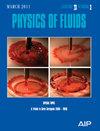混流式水轮机减载时涡旋演变的时空和能量耗散特性
IF 4.1
2区 工程技术
Q1 MECHANICS
引用次数: 0
摘要
本研究结合气蚀模型和结构动态网格技术,对混流式水轮机模型的减载效应进行了数值研究。结果表明,牵伸管中的蒸汽量经历了两次快速上升和下降,直至气蚀停止。随着椭圆度的增加,前冲涡绳从强螺旋结构过渡到轴向收缩,最终形成一个离散带,然后消失。最初,流道中的蒸汽量逐渐线性增加,随后持续增长,脉动振幅保持一致。叶片间漩涡(IBV)首先出现在叶片后缘,然后在脉动蒸汽量增长的驱动下发展成一个从流道冠延伸到叶片后缘的完整结构。流道提取的轴向力变化很大,与流道中蒸汽体积的变化密切相关。流道中的流体分离发生在流道冠附近,形成了双分离线,增强了 IBV 的形成,这突出表明了冠-近端流体分离对 IBV 发展的重要影响。在能量损失方面,在牵伸管和流道中都观察到了先减后增的现象,牵伸管的损失一直超过 57.4%,流道的损失超过 27.1%。湍流动能生成和雷诺应力是能量耗散的主要形式,高值区域与漩涡位置相对应,凸显了漩涡在能量耗散中的重要作用。这项研究为混流式水轮机减载过程中涡流和耗能特性的演变提供了新的见解。本文章由计算机程序翻译,如有差异,请以英文原文为准。
Temporal-spatial and energy dissipation characteristics of vortex evolutions in Francis turbine during load reduction
This study numerically investigates the load reduction effects, on a model Francis turbine, combining cavitation model and structured dynamic grid technique. The results indicate that the vapor volume in the draft tube undergoes two rapid increases and decreases until cavitation ceases. The precessing vortex rope transitions from a strong helical structure to axial contraction as ellipticity increases, ultimately forming a discrete band before disappearing. Initially, vapor volume in the runner increases gradually and linearly, followed by continued growth with a consistent pulsation amplitude. The inter-blade vortex (IBV) first appears at the blade trailing edge and then develops into a complete structure extending from the runner crown to the blade trailing edge, driven by pulsating vapor volume growth. Axial force extracted by the runner changes significantly and correlates closely with variations in the vapor volume in the runner. Flow separation in the runner occurs near the runner crown, forming dual separation lines that enhance IBV formation, which highlights the significant influence of crown-proximal flow separation on IBV development. Regarding energy loss, initial decreases followed by increases are observed in both the draft tube and runner, with draft tube losses consistently exceeding 57.4% and runner losses exceeding 27.1%. Turbulent kinetic energy generation and Reynolds stress are the primary forms of energy dissipation, with high-value regions corresponding to vortex locations, underscoring the substantial role of vortices in energy dissipation. This study provides new insights into the evolution of vortices and energy dissipation characteristics during load reduction in Francis turbines.
求助全文
通过发布文献求助,成功后即可免费获取论文全文。
去求助
来源期刊

Physics of Fluids
物理-力学
CiteScore
6.50
自引率
41.30%
发文量
2063
审稿时长
2.6 months
期刊介绍:
Physics of Fluids (PoF) is a preeminent journal devoted to publishing original theoretical, computational, and experimental contributions to the understanding of the dynamics of gases, liquids, and complex or multiphase fluids. Topics published in PoF are diverse and reflect the most important subjects in fluid dynamics, including, but not limited to:
-Acoustics
-Aerospace and aeronautical flow
-Astrophysical flow
-Biofluid mechanics
-Cavitation and cavitating flows
-Combustion flows
-Complex fluids
-Compressible flow
-Computational fluid dynamics
-Contact lines
-Continuum mechanics
-Convection
-Cryogenic flow
-Droplets
-Electrical and magnetic effects in fluid flow
-Foam, bubble, and film mechanics
-Flow control
-Flow instability and transition
-Flow orientation and anisotropy
-Flows with other transport phenomena
-Flows with complex boundary conditions
-Flow visualization
-Fluid mechanics
-Fluid physical properties
-Fluid–structure interactions
-Free surface flows
-Geophysical flow
-Interfacial flow
-Knudsen flow
-Laminar flow
-Liquid crystals
-Mathematics of fluids
-Micro- and nanofluid mechanics
-Mixing
-Molecular theory
-Nanofluidics
-Particulate, multiphase, and granular flow
-Processing flows
-Relativistic fluid mechanics
-Rotating flows
-Shock wave phenomena
-Soft matter
-Stratified flows
-Supercritical fluids
-Superfluidity
-Thermodynamics of flow systems
-Transonic flow
-Turbulent flow
-Viscous and non-Newtonian flow
-Viscoelasticity
-Vortex dynamics
-Waves
 求助内容:
求助内容: 应助结果提醒方式:
应助结果提醒方式:


